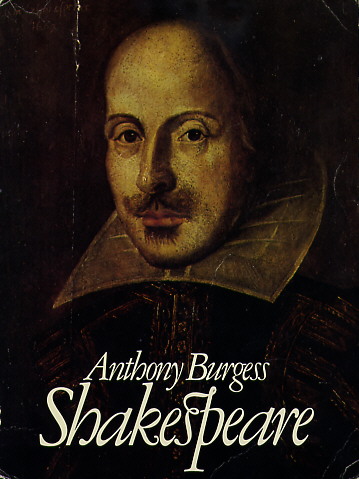The Elizabethan Theatre
by Anthony Burgess
The Elizabethan Theatreby Anthony Burgess |

|
The English drama
needs other things before it can become the Elizabethan tradition which
Shakespeare was to enter, to modify and to help eternise. First, it needs
a theatre. The physical structure which the Swan, the Rose, the Globe and
the Fortune had in common was derived out of the Elizabethan inn, the innyard
proving, to the wandering morality players, to be the most convenient location
for a one‑day stand. The square yard was enclosed by an upper gallery, on
to which the bedchambers opened. Here, then, was space for the casual groundlings,
standing‑room only, and, above, balcony accommodation for the better sort,
the ladies and gentlemen staying at the inn. The stage would be an improvised
platform at one end of the innyard, and the fixed gallery above might also
be used as an acting area. Play performances encouraged the sale of wine
and ale and, with the growth of potential audiences, some entrepreneurs were
encouraged to take over inns and turn them into permanent theatres. The stage
now became a fixed structure a platform or apron jutting into the auditorium;
a roof supported by pillars to keep rain off the players; the upper gallery
above the stage an essential element, though once a mere accident, and now
called the tarrass; a couple of doors for exits and entrances; a recess behind
the apron suitable for intimate scenes and called the study. The inn‑yard
origin was visible in outdoor theatres till the end, and the sale of liquid
refreshments was a lucrative adjunct to art. When Shakespeare's Globe was
burnt down in 1613, an auditor whose breeches were set on fire had the flames
doused with bottled ale.
from Anthony
Burgess, Shakespeare (1970)
Although many
details concerning the theatres are uncertain, the main features can be
briefly summarized.
Whether octagonal
in shape, like the Globe, or square, like the Fortune, a public playhouse
resembled a compact amphitheatre, with an unroofed central "yard" for the
groundlings, surrounded by tiers of covered galleries and the taller structure
of the actors' "tiring‑house". The main stage was a large platform, chest
high, jutting forward from the '"tiring‑house" nearly thirty feet into the
centre of the yard. As the platform, three parts surrounded, could not be
curtained off, there was no possibility of picture‑stage scenery; it was
usually bare, leaving the imagined stage locality fluid and indeterminate,
to be indicated, when necessary, by the actors themselves. Sometimes these
indications are vague (as in Edward II, where a speaker, somewhere in London
or near it, simply announces: "Here comes the king and the nobles From the
parliament"); sometimes they are more precise ("Well, this is the forest
of Arden"); the overriding concern, however, is rapidity of action. (...)
Visual, spectacular
appeal was by no means lacking, however. There were arras hangings black
for tragedy at the back of the stage; and the stage manager was well supplied
with large movable properties, bedsteads, arbours, mossy banks, "trees",
chariots, dragon outfits, even "i Hell mouth". Battles, executions, and bloodshed
in general could be staged with spectacular if conventionalized realism;
drownings, symbolically, with river‑gods appearing to carry the victims away.
Visual realism, then, took the form of an impressive token, as in medieval
staging, not a consistent setting; thus, the tents of two opposing army commanders
could be seen on the stage at once (Richard III, v. iii).
As there was
no artificial lighting (except in the expensive "private theatres, which
were roofed and candle‑lit), effects such as darkness had to be suggested
in the public theatres by means of tokens; but there was direct pictorial
interest in the many scenes of fighting, dancing, and procession. Expensive
and magnificent costumes were prominent here; they also served to designate
nationality, social status, or character. (...)
But the greatest
resource of the Elizabethan theatre was its unequalled adaptability. There
were two doors at the back of the main stage, which probably had a width
of forty‑one feet in the Globe; between these was a curtained alcove, the
rear stage, in which could be disclosed (or "discovered") an interior scene
with properties such as a study, a cave, or a shop. Above the rear stage,
and probably flanked by two usable windows, was a balcony stage, also curtained,
which could serve as a bedroom or the battlements of a castle, and could
be climbed or even assaulted from below (e.g. I Henry VI, ll.i). Above this
again, level with the third and top gallery of spectators, was the musicians'
gallery, which an actor could also use. And this flexible structure was
completed by two other features, reminiscent of the Middle Ages; above,
a painted canopy known as "the heavens", surmounted by a hut for properties
and supported by two pillars rising from the platform stage; and, below the
platform, the space of "hell". Both were pierced by trap‑doors, so that a
throne or a deity could be lowered, and a ghost, a devil or a magical tree
could arise from below, with spectacular effect. There were thus five levels
at which an actor could appear and perhaps, including trap‑doors, as many
as twenty‑two points of "discovery" or entrance.
Yet it remained
an intimate theatre. Front stage, the actor stood next to the groundlings;
rear stage, in the Globe, he was no more, apparently, than eighty‑five feet
away from the farthest spectator. There was thus no necessity to drop the
old convention of direct address to the audience, in soliloquy or aside;
it was a theatre for eloquence as much as for pageantry.